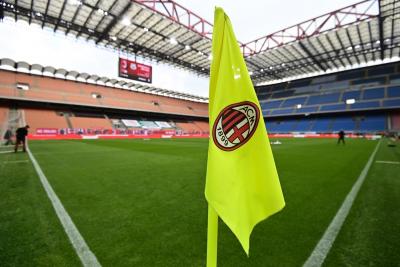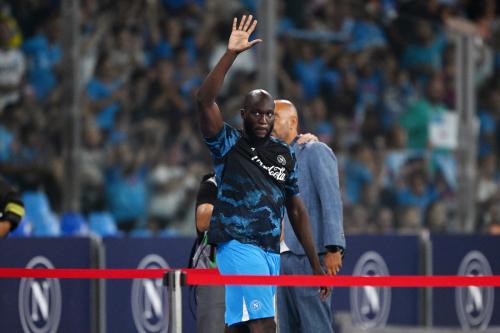'New investors in Italian football can have a positive impact': Dr Roberto Ciccioli on spending and investment in Serie A

ROME -- As the summer sun beats down in Rome, the tourist-lined Via della Conciliazione stretches down towards the gleaming white of St Peter’s Square. Halfway down the avenue is an open doorway and a typically Italian courtyard, shaded from view, which is enclosed by embassies and offices. I walk up the stairs of the palatial building to the fifth floor, where I have arranged to meet Dr Roberto Ciccioli.
Ciccioli is Head of Tax and Finance at Consultingcentre, a firm which offers tax and legal support to football clubs, players, and agents in Italy. In the same way this tucked away office watches down on Rome, Ciccioli’s role allows him to watch down on Italian football: hidden from plain sight but with the perfect vantage. “It’s an interesting job,” he says, “because we have a view on the whole football market.”
Ciccioli’s world of economics and finance is not something the average football fan, including myself, is trained in. But it has collided with the football sphere with increasing effect in the sport’s age of mega-spending owners, contractual amortisation (something many of us are experts on now), and financial tightrope-walking.
Those themes have emerged this summer during the calciomercato, an obsession in Italy as much as the football itself. According to Transfermarkt, Serie A clubs spent more this summer than in the 2023 window, paying over one billion euros in transfer fees this summer compared to just under 800 million euros last year. But Ciccioli suggests Italian clubs have still remained cautious and need to balance the books.
“It’s important to say Italian football doesn’t create cash flows [to allow] big expenses. In general terms, Italian clubs are able to make expenses of five, ten, 15 million euros on average based on their cash flows – taking into account player sales so that the balance is zero.”
Instead, the increase of spending has been facilitated by heavy reliance on the wealth of owners. “[The increase] was made possible by Juventus, because they spent a lot of money compared to the last transfer window. From my point of view, this reflects how Italian football is only able to spend if the clubs have owners that put the money in. In effect, Juventus made an increase in capital of 200 million euros, an increase of capital which made the spending possible.”
It was no surprise that Juventus were so active in the transfer window, with new manager Thiago Motta shaping his squad. The early signs of Motta’s imprint have underlined his desire to transform Massimiliano Allegri’s transitional team into a possession-based outfit. Juventus’s league campaign got off to a resounding success with the 3-0 win over Como, inspired by Samuel Mbangula’s debut goal to go with his electric performance. Then, in their second match against Verona, Italian Nicolò Savona also scored. Both players have come through the Juventus academy. Serie A clubs have been criticised in recent seasons for disregarding their young, particularly Italian, talent, but Ciccioli thinks academies could be one of the pillars for a club’s success.
“If you don’t start [young players], you never know,” he points out. “Obviously, there are some players immediately ready for the first team but there are some players that need to move from the academy to the second team and then to the first team. But it’s a matter of planning, a strategy which all the clubs must decide together to improve Italian football.”
There could, however, be a general model that Serie A clubs follow by placing academy players at its centre. Due to the league’s lack of financial might, owners of some clubs are building teams with younger talent, often on lower salaries and with potential to be developed. Some of this talent will be sold to bring in revenue. “An example is Calafiori, who was sold from Bologna to Arsenal after being at the academy at Roma and then in Basel. The transfer fee from Arsenal gave [Bologna] the opportunity to make money, [also] Roma where he was brought through.”
This view where academy players are considered pure profit by clubs, a debate also being waged in the Premier League, is a bleak prospect for Italian football. Ciccioli notes how Barcelona built their great team of the 2000s using the academy as a resource but, in Italy, some clubs are relying on the sale of academy talent. “This strategy is the only strategy for Italian clubs to maintain financial sustainability.”
Being able to spend money on new players also allows clubs, in theory, to be more competitive in European competitions. Since 2020, Italian clubs have reached eight UEFA finals and, despite dwarfing to Premier League finances, have competed well against teams from what Ciccioli calls a “Super League”. Just this week, Inter and Atalanta held Premier League heavyweights Manchester City and Arsenal to respective draws and, in the same competition, AC Milan have beaten Newcastle and Spurs in recent seasons, Napoli beat Liverpool in 2022, and Inter only narrowly lost the final 1-0 to Manchester City in 2023. The pattern seems to suggest the current Serie A strategy is working.
Part of the gulf between the leagues is down to the value of TV rights. The Premier League is one year into a four-year domestic deal worth nearly 8 billion euros and two years into a six-year deal with U.S. channel NBC worth 2 billion euros. By comparison, Serie A’s five-year domestic deal will earn 4.5 billion euros and the two-year licence sold to U.S. channel CBS is worth less than 70 million euros a season. Ciccioli argues Serie A football has to increase the value of broadcast deals in foreign markets like the U.S. and China but that it isn’t the only solution. “For me, Italian football has to [increase] its revenue through sponsorship, merchandise, and capital gains [through player sales], which can increase advertising and, in the long term, the [value of] TV rights.”
The gaping financial hole at the heart of Italian football cannot be resolved quickly, particularly in a league which is lacking star names like in England, Spain, or Germany. Serie A has chosen a more sustainable path to growth at the expense of recruiting expensive ‘brand’ players, in the mould of Cristiano Ronaldo at Juventus.
Ciccioli is certain Serie A will grow by increasing sponsorship and revenue, which can also be helped by foreign investors. But American ownership is becoming a particular point of contention across Europe, with nine of the 20 Serie A teams owned by North Americans including AC Milan, Inter, Atalanta, Fiorentina and Roma. The impact of the Red Bird Capital Group has been particularly decisive at Milan, seen similarly with Fiorentina’s Italian-born American owner Rocco Commisso, through recruitment of younger talent and a streamlining of behind-the-scenes operations – perhaps at the expense of immediate results.
But for Ciccioli, it is only “psychology” which is making some American investors unpopular. “American owners are more focused on the finances and less focused on understanding [club culture]. American owners will try to find an empathy with fans but are more focused on figures…From my point of view, new investors in Italian football can have a positive impact if they are serious and focused on the figures.”
Ciccioli insists that, despite Italian football’s financial issues, the impact of American ownership underlines it is still an attractive prospect to foreign investors. “The best investment is in a club in the second or third division of Italian football, able to restructure the current situation, the revenue, look at the figures, and get the club promoted.”
The success of Como, owned by Serie A’s richest owners, the Indonesian Djarum Group, also proves the point. “The owners of Como are demonstrating that even with a low fanbase, it is possible to create value,” Ciccioli says. “They have increased the enterprise value, for sure: they took the club from bankruptcy and now they are in Serie A. The strategy is clear.”
Ciccioli suggests Como’s financial model is also the blueprint for sustainable growth. The recruitment has centred on a blend of young players, like Nico Paz on loan from Real Madrid or Maximo Perrone from Manchester City, and experienced individuals, like Raphael Varane, Pepe Reina, and Andrea Belotti. “This means [the model] is sustainable, because they haven’t spent hundreds of millions on playing, they are only paying the salary of some players [brought in on loan or as free agents] – and those salaries will be paid for by the TV rights.”
But, according to Ciccioli, Como’s model is not the only one which Serie A clubs should follow. He points to Real Madrid’s success as a fan-owned club, becoming the first club to record an annual revenue of one billion euros. Ciccioli thinks Roma and Napoli should follow suit: “they have a huge fanbase which can give them the financial resources to [launch] a process of growth.”
Italian football, therefore, finds itself at a crossroads on the path to growth: it can either hand over its keys to its fans or trust foreign investment models which often see fans as a cog in a machine of revenue and profit. There is a middle ground, Ciccioli suggests, by following clubs like Borussia Dortmund, who mix young and experienced players, have a strategy for growth, compete for major trophies, and can be sustainable enough through the sale of players like Erling Haaland or Jude Bellingham. But can fans really be kept happy by their club’s growth if it does not come alongside winning silverware? The direction of Serie A is uncertain but, for Ciccioli, one thing is clear: “I think Inter will win the Scudetto.”
bq

© COPYRIGHT ITALIAN INSIDER
UNAUTHORISED REPRODUCTION FORBIDDEN


